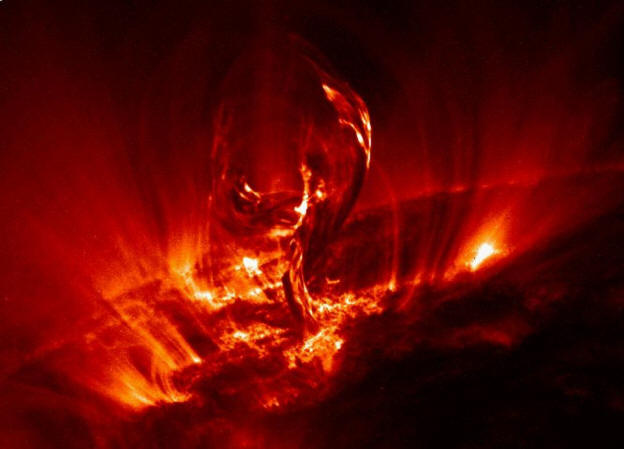|

UV image of a 100,000 kilometer exploding solar
filament (July 19, 2000). Credit: ESA/NASA/SOHO.
Solar Breeze
Nov
22, 2010
This TPOD
originally ran on Dec 7, 2009.
The intensity of the Sun's
magnetic field and solar wind have
declined to a record low level.
On August 25, 1997, NASA launched
the Advanced Composition Explorer ( ACE)
satellite on a mission to monitor
energetic ions coming from the Sun,
as well as higher energy particles
(cosmic rays) thought to be arriving
from intergalactic space.
ACE is in orbit around the
L1 LaGrange point
approximately 1,500,000 kilometers
from Earth and will remain there
until 2024. Scientists hope that
data from the spacecraft's onboard
sensors will help them understand
how the Solar System formed,
including how the solar magnetic
field moderates incoming high-speed
ions. Several research groups have
been investigating a possible link
between our climate and cosmic rays.
During periods of high activity,
energetic pulses on the Sun eject
charged particles in the billions of
tons. They are normally slow moving,
requiring about 24 hours to reach
Earth. Known as Coronal Mass
Ejections (CME), an indication of
their arrival is an intensification
of the aurorae.
Although the Sun is in a
relatively quiescent state with few
sunspots visible, it occasionally
erupts with solar flares that can
reach incredible velocities. As a
matter of observation, they continue
to accelerate as they move away from
the Sun. What explains this
counterintuitive process?
Sunlight reaches Earth in
approximately eight minutes. A solar
ejection arriving in 30 minutes must
be moving at more than a quarter of
the speed of light. In the consensus
view, such velocities are a profound
mystery, yet a gigantic CME was
observed on January 17, 2005, that
reached our planet in less than half
an hour. How do CMEs accelerate to
75,000 kilometers per second or
more?
Plasma physicist
Tony Peratt
wrote: “...electric fields aligned
along the magnetic field direction
freely accelerate particles.
Electrons and ions are accelerated
in opposite directions, giving rise
to a current along the magnetic
field lines.”
Rather than shock fronts or
so-called "magnetic reconnection
events," the solar wind receives its
impetus from an electric field that
emanates from the Sun in all
directions. The easiest way for
charged particles to accelerate is
within such a field. The Sun's
e-field extends for billions of
kilometers, ending at the
heliospheric boundary, which the
twin
Voyager spacecraft are
just now beginning to penetrate.
The "mysterious" acceleration of
positively charged solar wind
particles is an electrical
phenomenon that is predicted by the
Electric Sun model.
Solar flares are labeled C, M, or
X: light, medium, or powerful. The
January 17 CME was rated X3.
However, on September 7, 2005,
an X17 CME impacted
Earth's magnetosphere, knocking out
radio transmissions and overloading
power station transformers. A
veritable cosmic tornado of positive
ions poured into the electrically
charged environment of our planet.
Is it a coincidence that
hurricanes Katrina and Rita occurred
on either side of the second largest
X-flare ever recorded?
In 1997, Henrik Svensmark and
Eigil Fris-Christensen published
"Variation of Cosmic Ray Flux and
Global Cloud Coverage – a Missing
Link in Solar–Climate Relationships"
in which they argue for the Sun's
mediating influence on Earth's
climate. Essentially, the greater
the number of high-energy ions that
enter our magnetic field, the
greater will be the cloud cover.
When the Sun enters a quiet phase
in its 22 year cycle, more charged
particles are able to reach Earth
because the solar magnetic field is
not strong enough to deflect them.
As they encounter our watery
atmosphere, they cause clouds to
form. Similar to an old-fashioned
cloud chamber, when fast moving ions
fly through a region of high
humidity a track of condensation
appears. It was those threads of
tiny droplets that were once used to
monitor subatomic particles produced
by linear accelerators or
"atom-smashers."
Mike Lockwood and Claus Fröhlich
issued a paper in 2007 that
contradicted any idea of a
heliocentric influence on cloud
cover. Although they acknowledge
that it might have had a small
effect in the past, they assert that
humanity's industrial activity is so
great that it overshadows a solar
connection. Of course, they
completely ignore the role of
electricity in space and contend for
purely mechanistic and chemical
interactions.
To Electric Universe theorists,
the relationship between incoming
high-speed protons from CMEs and
increased storm activity, coupled
with the analysis offered by
Svensmark and Fris-Christensen,
is not coincidental. Since water is
a dipolar molecule, the fact that
ions attract water vapor seems
indisputable.
Stephen Smith
|







